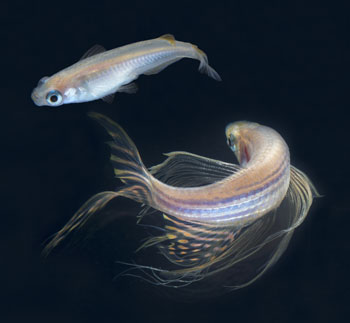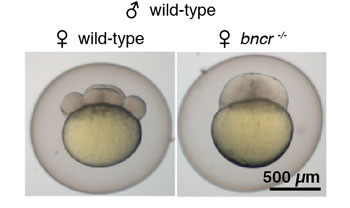|
Figure 1: Adult medaka (Oryzias latipes, top) and zebrafish (Danio rerio, bottom) (credit: Tibor Kulczar/Sarah Herberg/Andrea Pauli, IMP). |
Fertilization results from the interaction and consequent fusion of a sperm and an egg, leading to the formation of a single cell—the zygote. This process is fundamental for all sexually reproducing species, ensuring that they can both self-perpetuate and remain distinct from other species. Despite being so fundamental, there is surprisingly little known about the underlying molecular mechanisms. In mammals, there are in total three proteins known to be essential for sperm-egg-interaction: Izumo on the sperm (Inoue et al., 2005) and its binding partner Juno on the egg (Bianchi et al., 2014), and the tetraspanin-type protein called CD9 (Le Naour et al., 2000; Kaji et al., 2000). Yet, these three factors cannot explain the high efficiency and species-specificity of fertilization, two seemingly contradictory hallmarks.
While ensuring species-specificity of fertilization at the stage of sperm-egg interaction is less important for mammals like us with internal fertilization, since prior mate-selection can limit sperm-egg interaction to gametes within a given species, such mechanisms are essential for organisms with external fertilization (Figure 1) since gametes are often released into the open water. Egg and sperm from the same species then need to meet and fuse, while sperm from a different species should be rejected. How nature has solved the problem of efficiency versus specificity is a big mystery, particularly in vertebrates with external fertilization, such as fish.
|
|
We identified an un-annotated, short, predicted protein-coding gene, which we call Bouncer, as a crucial species-specific fertilization factor in zebrafish (Herberg et al., 2018). We show that Bouncer, which is expressed on the egg membrane, is essential for sperm entry into the egg (Figure 2) and mediates sperm-egg interaction. Remarkably, expressing medaka Bouncer on zebrafish eggs is sufficient to allow cross-species fertilization between the two evolutionary distant fish species, zebrafish and medaka, resulting in hybrid embryos (Figure 3). We therefore posit that Bouncer acts as the gatekeeper of the oocyte: it allows conspecific sperm to enter, while keeping heterospecific sperm out.

Figure 3: Zebrafish sperm fertilizes wild-type zebrafish eggs (left), in contrast to medaka sperm, which fails to fertilize wild-type zebrafish eggs (middle). However, zebrafish eggs mutant for zebrafish Bouncer and instead expressing medaka Bouncer can be fertilized by medaka sperm and develop into zebrafish-medaka hybrid embryos (right). Images show embryos at one day after fertilization.
While we have so far only evidence for Bouncer’s crucial role in species-specific fertilization in fish, mammals have a homolog of Bouncer, SPACA4 (sperm acrosome membrane-associated protein 4) that is also expressed in the germline (Shetty et al., 2003; Herberg et al., 2018). Yet unlike in organisms with external fertilization, where Bouncer is expressed exclusively on the egg, organisms with internal fertilization express SPACA4 on the sperm. Whether Bouncer’s homolog SPACA4 has a key function in fertilization in mammals remains to be tested in the future.
Overall, our study has identified a new fertilization factor in vertebrates that provides a key piece in the puzzle to how species-specific fertilization can be efficient.
Reference
The Ly6/uPAR protein Bouncer is necessary and sufficient for species-specific fertilization. Herberg, S., Gert, K.R., Schleiffer, A., and Pauli, A. (2018). Science 361, 1029–1033.
Link to accompanying perspective on this article




































 Figure 2: Females lacking Bouncer protein lay eggs that cannot be fertilized and do not develop beyond the 1-cell stage.
Figure 2: Females lacking Bouncer protein lay eggs that cannot be fertilized and do not develop beyond the 1-cell stage.